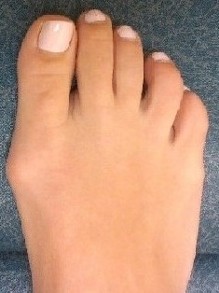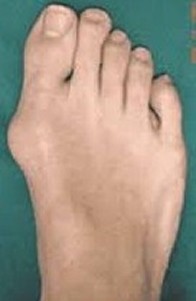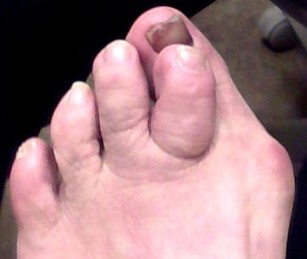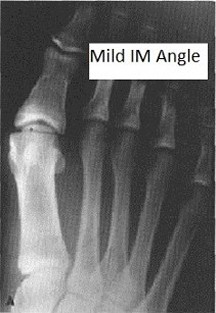Bunion (Hallux Abducto Valgus)
Bunions can be categorized into mild, moderate, or severe. The severity of the bunion determines what kind of surgery, if any, needs to be done.
Typically, the more severe the bunion, the more involved the procedure and the longer the post-op course. The type of surgery you need may also determine whether or not you’ll need crutches after surgery, or if you’ll be able to walk right away in a walking boot.
There are examples of mild, moderate, and severe bunions below; but it’s always best to consult a Foot and Ankle Surgeon for a thorough exam to determine which type of bunion you have and what the most appropriate surgery will be considering your overall health and activity level.

Mild Bunion Deformity

Moderate Bunion Deformity

Severe Bunion Deformity
The terms mild, moderate, and severe generally relate to what’s called the IM (Intermetatarsal) Angle of a bunion. The pictures below shows what a mild, moderate, and severe IM angle look like.


IM (Intermetatarsal Angle)



Mild bunions can typically be fixed using a procedure is the distal aspect of the metatarsal head (the part of the bone nearest the toe). As the bunion progresses, however, the bone cuts need to move further back, giving the patient a longer lever arm to correct the more severe bunions.
Sometimes, if the bunion is very severe or the foot is overly flexible a fusion of a joint may be necessary. See Surgical Procedures for more details on surgical correction or watch some examples.
Dorsal Bunion (Hallux Limitus or Rigidus)
Some people have what is sometimes referred to as a Dorsal Bunion. This type of bunion is actually arthritis of the 1st big toe joint. This arthritis limits motion of the joint and can also make motion of the big toe joint very painful. The arthritic process can form spurs on all around the big toe joint, making shoe gear painful for the patient. Surgeries to correct this problem also differ with the severity of the arthritis. See our Surgical Procedure tab for specifics or watch some animations of procedures at www.texasfootdoctor.org.

Hallux Limitus/Rigidus (Arthritis of the 1st Big Toe Joint)
Hallux Varus
This is a condition where the big toe joint dislocation in the opposite direction as the above described bunion. This can be caused from trauma, genetics, or as a complication from bunion surgery.
Correction of hallux varus may include bone cuts, soft tissue repair, or a combination of both.

Hallux Varus



